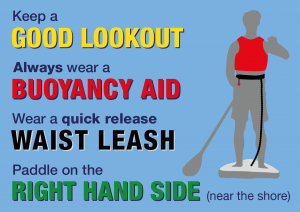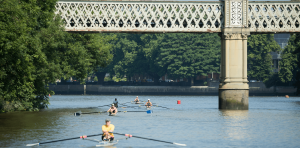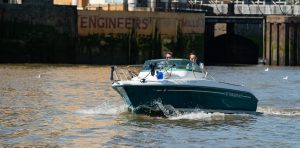

The Port of London Authority owns and operates Richmond Lock and Weir, which is also the base for the upper Thames harbour service patrols between Putney and Teddington Lock.

Essential, up to date safety information and advice for water sports participants and those supporting navigation and commercial shipping on the tidal Thames.
Situated between Teddington and Richmond, the weir comprises three vertical steel sluice gates suspended from a footbridge. Each gate weighs 32.6 tonnes and is 20 metres wide and 3.64 metres in depth.
For around two hours each side of high tide, the sluice gates are raised into the footbridge structure above, allowing ships and boats to pass through the barrage. For the rest of the day the sluice gates are closed and passing river traffic must use the lock alongside the barrage.
This period of free navigation can be dramatically changed due to prevailing conditions. In drought conditions the gates will be closed for longer periods, whilst in periods of high fluvial flow they may remain open for much longer. For current information please contact the Lock Foreman on 0208 940 0634.
The sluice gates ensure that the water level betwen Richmond Lock and Teddington Lock is maintained at or above half-tide level.
The structure was officially opened by the Duke and Duchess of York in 1894.
PLA completed a major, £4 million refurbishment of the lock and weir in the early 1990’s. It underwent a £500,000 repaint that was completed in February 2020.
Navigating Richmond Lock and Weir
A half-tide lock and rising sluice gates operate at Richmond. The lock is 76m long and 8m wide. Use of the lock, which has a Lock Foreman on duty 24 hours a day, is charged at £10 for all classes of recreational vessels (2022 charges):
When the sluice gates are down and the weir closed, the following signals are in operation:
- By Day – 3 red discs in the form of an inverted triangle shown at each arch.
- By Night – An inverted triangle of 3 red lights at each arch.
In addition an illuminated sign on the upper end of lock entrance reads ‘Weirs are closed please use Lock’. The lock must be used in these circumstances.
For approximately 2 hours either side of high water the weir sluice gates are raised allowing free passage. At these times the following signal is displayed by day and night:
- Two amber lights shown at each arch – weir open, free navigation.
Mooring trots along the Deer Park bank are expressly for the use of those craft waiting to use the lock. Small craft rollers in the Isleworth bank arch are available for canoes and skiffs instead of locking. At low water the depth below the weir is restricted and care should be taken when approaching from downstream. The maintained level of water above the weir is 1.72m above OD Newlyn.
Multiple low tide predictions at Richmond Lock and Weir
This phenomenon is not an error but due to the prolonged low water period that exisits at Richmond. The prediction programme looks for the turning points in the tidal cycle (i.e. where the tide changes from rising to falling). At Richmond this means that slight variations in the prediction can result in consecutive “low” waters. The multiple low waters have not been edited out of the tide tables so as to illustrate the low water stand that occurs.
Advice on safely enjoying the tidal Thames from the Port of London Authority.

Stand-up Paddlers Safety Card
The Stand-up Paddlers Safety Card offers advice on staying safe on the River Thames while paddleboarding.

Ebb Tide Flag Warning
The latest Port of London Authority advice to river users about the current tidal fluvial flow on the River Thames.

Information on the Regulations Applicable to Pleasure Vessels
Pleasure craft can be considered to be vessels that are used for sport or recreational purposes only and do not operate for any financial gain to the owner.

The Tideway Code
Navigating any type of small recreational vessel on the tidal Thames, or Thames Tideway as it is also known, requires knowledge of the river and how it operates.

Recreational Users Guide
Navigating any type of small recreational vessel on the tidal Thames, or Thames Tideway as it is also known, requires knowledge of the river and how it operates.

Vessel Licensing Byelaws 2014
Navigating any type of small recreational vessel on the tidal Thames, or Thames Tideway as it is also known, requires knowledge of the river and how it operates.

